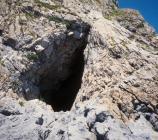The Cave Men of Ice Age Wales
Items in this story:
The Ice Age in Wales
Humans have lived in Wales for over a quarter of a million years, first by the Neanderthals and then by modern humans. Evidence for the first human occupation of Wales can be found in caves around the country.
The 'Palaeolithic' or 'Early Stone Age' period is the time popularly known as the 'Ice Age'. It saw very cold periods (known as glacials) when ice covered all of Wales, and warm periods (interglacials), like the one in which we live today.
It is against this backdrop of changing climate that our earliest ancestors evolved from their African origins, migrated across Europe and Asia, and developed into modern humans.
In Wales most of the evidence we have for the earliest Palaeolithic settlements come from caves. These caves are found in limestone areas, for example in parts of Denbighshire, Gower and south Pembrokeshire.
The Neanderthals
The first evidence we have for humans in Wales comes from the site of Pontnewydd Cave (Denbighshire). Here, excavations have identified the remains of an early form of Neanderthal, that lived around 230,000 years ago.
Neanderthals were hunters and their tools show that they needed to get close to their prey in order to kill. Neanderthal skeletons excavated around Europe have a very high number of broken bones, suggesting that they may often have come off worst from these encounters.
The Neanderthals at Pontnewydd Cave made tools using the local stones picked up near the cave; including cutting tools, scrapers and hand axes. Handaxes have been discovered at Coygan Cave in Carmarthenshire — a site now destroyed by quarrying.
Climate change
Coygan Cave was used briefly as a lookout point by Neanderthals some time between 60,000 and 40,000 years ago. The cave was then used as a den by hyeanas as the last glacial began.
It is possible that this deterioration in the climate is the reason for the extinction of the Neanderthals, who died out around 35,000 years ago.
Modern Humans
Modern humans, like us, first appear in Europe about 60,000 years ago. Our appearance is marked by the use of new types of stone tools made from long thin blades struck from a block of flint. These blades were much more versatile than those of the Neanderthals.
Paviland Cave — The earliest human burial in Britain
Early modern humans also developed the first art. Cave paintings from this period have survived in France and northern Spain — areas unaffected by the return of the glaciers. In Wales no cave art has yet been discovered, but engraved and carved bones have been found. Perhaps the most significant site to have produced this material is Paviland Cave (Gower). This is home to the earliest human burial found in Britain, dating to around 26,000 years ago.
Other caves occupied during this early part of the last glacial include Cae Gwyn and Ffynnon Beuno (both in Denbighshire), and Hoyles Mouth (Pembrokeshire). This latter cave was used around 30,000 years ago. After this time, ice sheets spread across Wales reaching their greatest extent between 20,000 and 18,000 years ago, at this time, animals retreated south, forcing the people who hunted them to follow.
Around 18,000 years ago the ice sheets began a slow retreat and the animals and people returned. We believe they had returned by around 14,500 years ago, but the earliest evidence from Wales dates to around 12,500 years ago at caves such as Paviland and Hoyles Mouth.
With the end of the last glacial, about 11,500 years ago, the evidence for people living in Wales increases greatly and changes in character. This date is used to mark the end of the Early Stone Age (Palaeolithic) and the start of the Middle Stone Age (Mesolithic).
Background Reading
Ice Age hunters: neanderthals and early modern hunters in Wales by Stephen Green and Elizabeth A. Walker. Published by the National Museum of Wales (1991).



